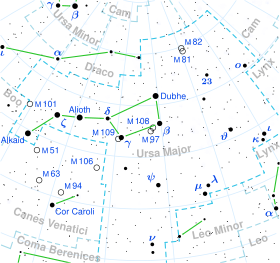
| |
| Observation data Epoch J2000.0 Equinox J2000.0 (ICRS) | |
|---|---|
| Constellation | Ursa Major |
| Right ascension | 10 53 58.74035 |
| Declination | +43° 11′ 23.8483″ |
| Apparent magnitude (V) | 4.61 |
| Characteristics | |
| Spectral type | A1VsSi: or A0 IV−V |
| U−B color index | −0.11 |
| B−V color index | −0.04 |
| Astrometry | |
| Radial velocity (Rv) | −18.70±0.80 km/s |
| Proper motion (μ) | RA: +42.97 mas/yr Dec.: −23.62 mas/yr |
| Parallax (π) | 13.24 ± 0.50 mas |
| Distance | 246 ± 9 ly (76 ± 3 pc) |
| Absolute magnitude (MV) | +0.86 |
| Orbit | |
| Period (P) | 15.8307 d |
| Eccentricity (e) | 0.31 |
| Periastron epoch (T) | 2435185.246 JD |
| Argument of periastron (ω) (secondary) | 27.3° |
| Semi-amplitude (K1) (primary) | 22.2 km/s |
| Details | |
| Radius | 2.5 R☉ |
| Luminosity | 76 L☉ |
| Surface gravity (log g) | 3.88 cgs |
| Temperature | 9,647 K |
| Rotational velocity (v sin i) | 47 km/s |
| Age | 325 Myr |
| Other designations | |
| ω UMa, 45 Ursae Majoris, BD+43°2058, FK5 2870, HD 94334, HIP 53295, HR 4248, SAO 43512 | |
| Database references | |
| SIMBAD | data |
Omega Ursae Majoris (Omega UMa, ω Ursae Majoris, ω UMa) is a binary star system in the northern circumpolar constellation of Ursa Major. It is visible to the naked eye with an apparent visual magnitude of 4.61. Based upon an annual parallax shift of 13.24 mas, it is roughly 246 light years from the Sun. At that distance, the visual magnitude of the star is diminished by an extinction factor of 0.11 due to interstellar dust.
This is a single-lined spectroscopic binary star system with an orbital period of 15.8 days and an eccentricity of 0.31. The primary member, component A, is an A-type main sequence star with a stellar classification of A1VsSi:. The stellar spectrum has the appearance of a hot Am star, showing overabundances of many iron-peak and heavier elements, but an underabundance of helium. In particular, it has an abnormal abundance of silicon.
Naming
In Chinese, 天牢 (Tiān Láo), meaning Celestial Prison, refers to an asterism consisting of ω Ursae Majoris, 57 Ursae Majoris, 47 Ursae Majoris, 58 Ursae Majoris, 49 Ursae Majoris and 56 Ursae Majoris. Consequently, the Chinese name for ω Ursae Majoris itself is 天牢一 (Tiān Láo yī, English: the First Star of Celestial Prison.).
References
- ^ van Leeuwen, F. (2007), "Validation of the new Hipparcos reduction", Astronomy and Astrophysics, 474 (2): 653–664, arXiv:0708.1752, Bibcode:2007A&A...474..653V, doi:10.1051/0004-6361:20078357, S2CID 18759600.
- ^ Mermilliod, J.-C. (1986), "Compilation of Eggen's UBV data, transformed to UBV (unpublished)", Catalogue of Eggen's UBV Data, SIMBAD, Bibcode:1986EgUBV........0M.
- ^ Cowley, A.; et al. (April 1969), "A study of the bright A stars. I. A catalogue of spectral classifications", Astronomical Journal, 74: 375–406, Bibcode:1969AJ.....74..375C, doi:10.1086/110819.
- ^ Adelman, S. J. (2005), "The physical properties of normal a stars", Proceedings of the International Astronomical Union, 2004: 1–11, Bibcode:2004IAUS..224....1A, doi:10.1017/S1743921304004314.
- de Bruijne, J. H. J.; Eilers, A.-C. (October 2012), "Radial velocities for the HIPPARCOS-Gaia Hundred-Thousand-Proper-Motion project", Astronomy & Astrophysics, 546: 14, arXiv:1208.3048, Bibcode:2012A&A...546A..61D, doi:10.1051/0004-6361/201219219, S2CID 59451347, A61.
- ^ Gontcharov, G. A. (November 2012), "Spatial distribution and kinematics of OB stars", Astronomy Letters, 38 (11): 694–706, arXiv:1606.09028, Bibcode:2012AstL...38..694G, doi:10.1134/S1063773712110035, S2CID 119108982.
- ^ Pourbaix, D.; Tokovinin, A. A.; Batten, A. H.; Fekel, F. C.; Hartkopf, W. I.; et al. (2004), "SB: The ninth catalogue of spectroscopic binary orbits", Astronomy & Astrophysics, 424 (2): 727–732, arXiv:astro-ph/0406573, Bibcode:2004A&A...424..727P, doi:10.1051/0004-6361:20041213, S2CID 119387088.
- Pasinetti-Fracassini, L. E.; et al. (February 2001), "Catalog of Apparent Diameters and Absolute Radii of Stars (CADARS)", Astronomy and Astrophysics, 367 (3rd ed.): 521–524, arXiv:astro-ph/0012289, Bibcode:2001A&A...367..521P, doi:10.1051/0004-6361:20000451, S2CID 425754.
- ^ McDonald, I.; et al. (2012), "Fundamental Parameters and Infrared Excesses of Hipparcos Stars", Monthly Notices of the Royal Astronomical Society, 427 (1): 343–57, arXiv:1208.2037, Bibcode:2012MNRAS.427..343M, doi:10.1111/j.1365-2966.2012.21873.x, S2CID 118665352.
- Royer, F.; et al. (February 2007), "Rotational velocities of A-type stars. III. Velocity distributions", Astronomy and Astrophysics, 463 (2): 671–682, arXiv:astro-ph/0610785, Bibcode:2007A&A...463..671R, doi:10.1051/0004-6361:20065224, S2CID 18475298.
- "* ome UMa", SIMBAD, Centre de données astronomiques de Strasbourg, retrieved 2017-02-22.
- Caliskan, Hulya; Adelman, Saul J. (June 1997), "Elemental abundance analyses with DAO spectrograms - XVII. The superficially normal early A stars 2 Lyncis, omicron Ursa Majoris and phiAquilae", Monthly Notices of the Royal Astronomical Society, 288 (2): 501–511, Bibcode:1997MNRAS.288..501C, doi:10.1093/mnras/288.2.501.
- Renson, P.; Manfroid, J. (May 2009), "Catalogue of Ap, HgMn and Am stars", Astronomy and Astrophysics, 498 (3): 961–966, Bibcode:2009A&A...498..961R, doi:10.1051/0004-6361/200810788.
- (in Chinese) AEEA (Activities of Exhibition and Education in Astronomy) 天文教育資訊網 2006 年 6 月 21 日 Archived 2016-03-03 at the Wayback Machine